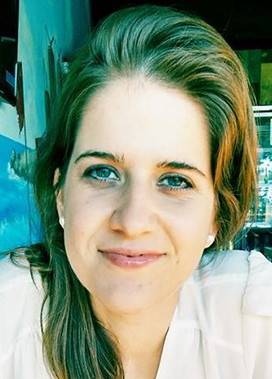Teresa Walch Lecture (Summary)

Teresa Walch (University of California, San Diego)
"Excluding Jews from their Homeland and Erasing ‘Jewish Spaces’ in Nazi Germany”
February 9, 2017
In her public lecture on Feb. 9, 2017, at USC, Robert J. Katz Research Fellow Teresa Walch outlines the process by which Jews in Berlin lost their rights, access to public spaces, ability to move freely, and finally their own homes, from 1933-38. Throughout her talk, Walch refers to the testimonies in the Visual History Archive that she has discovered of Holocaust survivors who describe living through this period and its effect on them.
Teresa Walch, the 2016-2017 Inaugural Robert J. Katz Research Fellow in Genocide Studies, gave a public lecture at the USC Shoah Foundation Center for Advanced Genocide Research focusing on the calculated and gradual exclusion of Jews from public spaces and ultimately from their own homes that began in the 1930s. This research is part of her wider dissertation research on the crucial role space played in the Nazis’ rise to and consolidation of power as Nazis sought to redesign space to fit their ideological visions.
Walch began her lecture by defining “Jewish spaces” in the title of her talk. In this category, Walch includes not only the spaces that Jews built for themselves, but also spaces that they inhabited and spaces where they worked. Even spaces that Jews or others think of as ‘being Jewish’ can be considered a “Jewish space,” Walch explained.
While Kristallnacht -- the November pogrom in 1938 -- has received a great deal of attention, Walch pointed out that much vandalism preceded and followed it. Vandals frequently targeted Jewish homes and stores, defacing properties with swastikas and graffiti, throwing stones through windows. These actions were driven from below. Walch described how interviews from the USC Shoah Foundation Visual History Archive reveal that the events of Kristallnacht were far more violent and substantial than reflected in the scholarly literature. Again and again, survivors describe aggressors using axes and sledgehammers, destroying their private property, shattering dishes, smashing grandfather clocks and pianos. This was destruction for destruction’s sake, aimed at inflicting maximum damage.
After focusing on vandalism and destruction of Jewish spaces, Walch moved on to analyzing the exclusion of Jews from public spaces and responses to that exclusion by Jews and non-Jews. Increasing restrictions placed on Jews after 1933 were aimed at isolating them and banning them from public spaces. The Nazis began pervasively marking and designating spaces as areas for Jews and areas for Germans or Aryans -- stores, restaurants, buses, sidewalks, and even park benches. Over and over again in the testimonies, survivors recall the signs they frequently encountered that barred them from sitting on benches, bathing in swimming pools, entering cafes, bars, or restaurants. In some testimonies, survivors describe ignoring the bans, acting like they didn’t see the signs. In other cases, some obeyed the bans out of fear. As social pressure grew to isolate Jews, restrict their movements and freedom, and deprive them of their rights as German citizens, alternative spaces within the Jewish community or offered by Zionist organizations became sites of refuge and community-building, Walch argued. As restrictions mounted, unwritten rules and pressures followed. Even mundane actions could be politicized, such as greeting one another in public or shaking hands on the street. People began to avoid these types of interactions, and as reflected in the testimonies, many Jews tried to become as inconspicuous as possible.
After the pogrom of 1938, the German government passed laws that forced Jews to sell their businesses and led to the eviction of Jews from their homes, forcing Jews into shared apartments. In May 1939, areas of Berlin were declared to be Jew-free (“Judenrein”). Survivors describe a growing sense of entrapment and suffocation at this time. Later, Nazis accelerated deportation plans, seeking to erase Jews from cityscapes entirely. Visible reminders remained of the Jews in the spaces they left behind, and Nazis set out to transform these spaces as well – dynamiting or repurposing synagogues, renaming squares and streets, demolishing monuments, selling Jewish cemeteries, grinding gravestones down to rocks. Jewish homes and apartments were reallocated with furniture, books, art, and sometimes even religious objects left behind, sometimes troubling the new inhabitants in one case Walch detailed.
In 1933, the Holocaust was not predetermined, Walch reminded the audience. Mass exterminations were still many years away, not to begin until 1941. The segregation of Jews from the early 1930s onwards was a crucial antecedent to the Holocaust. The processes of exclusion that she analyzes began making the Holocaust imaginable, Walch argued. Anti-Semitism was the driving force. This “othering” required effort. It mattered that people stopped greeting each other in the streets. It mattered that people accepted the segregation of Jews. Walch argued that the vandalism and destruction of Jewish spaces, accompanied by the gradual and calculated exclusion of Jews from public spaces, from their own private spaces, then from the cityscape itself, visibly reified the Nazi belief that Jews could not be German.
A great deal of the lively Q&A discussion that followed Walch’s lecture focused on the challenges of defining “Jewish spaces.” In addition, Walch discussed the significance of the Visual History Archive interviews as rare and valuable sources of descriptions of everyday life in Germany before the war. She discussed Jewish spaces in Berlin today and how those are related to the influx of Israelis who have moved to Berlin.
Summary by Martha Stroud
Like this article? Get our e-newsletter.
Be the first to learn about new articles and personal stories like the one you've just read.